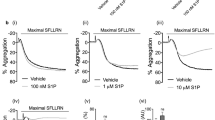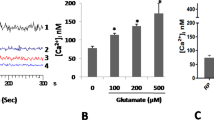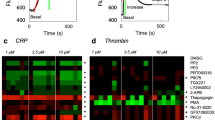Abstract
Activated platelets bind numerous adhesive and procoagulant proteins by receptor-mediated processes1. Although there is little evidence to suggest that these processes are heterogeneous in platelets, we previously found that platelets co-stimulated with collagen and thrombin express functional α-granule factor V only on a subpopulation of cells2. Here we show that these cells, referred to as ‘COAT-platelets’, bind additional α-granule proteins, including fibrinogen, von Willebrand factor, thrombospondin, fibronectin and α2-antiplasmin. These proteins are all transglutaminase substrates, and inhibitors of transglutaminase prevent the production of COAT-platelets. A synthetic transglutaminase substrate (CP15) also binds to COAT-platelets, and analysis by high performance liquid chromatography/mass spectrometry shows that a product is formed with a relative molecular mass (Mr) equal to CP15 plus 176. Serotonin, an abundant component of platelet-dense granules3, has an Mr of 176, and fibrinogen isolated from COAT-platelets contains covalently linked serotonin. Synthetic bovine serum albumin-(serotonin)6 binds selectively to COAT-platelets and also inhibits the retention of procoagulant proteins on COAT-platelets. These data indicate that COAT-platelets use serotonin conjugation to augment the retention of procoagulant proteins on their cell surface through an as yet unidentified serotonin receptor.
This is a preview of subscription content, access via your institution
Access options
Subscribe to this journal
Receive 51 print issues and online access
$199.00 per year
only $3.90 per issue
Buy this article
- Purchase on Springer Link
- Instant access to full article PDF
Prices may be subject to local taxes which are calculated during checkout





Similar content being viewed by others
References
Ware, J. A. & Coller, B. S. in Williams Hematology (eds Beutler, E., Lichtman, M. A., Coller, B. S. & Kipps, T. J.) 1161–1201 (McGraw-Hill, New York, 1995).
Alberio, L., Safa, O., Clemetson, K. J., Esmon, C. T. & Dale, G. L. Surface expression and functional characterization of α-granule factor V in human platelets: Effects of ionophore A23187, thrombin, collagen and convulxin. Blood 95, 1694–1702 (2000).
McNicol, A. & Israels, S. J. Platelet dense granules: structure, function and implications for haemostasis. Thromb. Res. 95, 1–18 (1999).
Greenberg, C. S., Birckbichler, P. J. & Rice, R. H. Transglutaminases: multifunctional cross-linking enzymes that stabilize tissues. FASEB J. 5, 3071–3077 (1991).
Pincus, J. H. & Waelsch, H. The specificity of transglutaminase. II. Structural requirements of the amine substrate. Arch. Biochem. Biophys. 126, 44–52 (1968).
Puszkin, E. G. & Raghuraman, V. Catalytic properties of a calmodulin-regulated transglutaminase from human platelet and chicken gizzard. J. Biol. Chem. 260, 16012–16020 (1985).
Muszbek, L., Adany, R. & Mikkola, H. Novel aspects of blood coagulation factor XIII. I. Structure, distribution, activation, and function. Crit. Rev. Clin. Lab. Sci. 33, 357–421 (1996).
Polgar, J. et al. Platelet activation and signal transduction by convulxin, a C-type lectin from Crotalus durissus terrificus (tropical rattlesnake) venom via the p62/GPVI collagen receptor. J. Biol. Chem. 272, 13576–13583 (1997).
Aeschlimann, D. & Paulsson, M. Transglutaminases: Protein cross linking enzymes in tissues and body fluids. Thromb. Haemost. 71, 402–415 (1994).
Parameswaran, K. N., Velasco, P. T., Wilson, J. & Lorand, L. Labeling of ε-lysine crosslinking sites in proteins with peptide substrates of factor XIIIa and transglutaminase. Proc. Natl Acad. Sci. USA 87, 8472–8475 (1990).
Lorand, L., Stern, A. M. & Velasco, P. T. Novel inhibitors against the transglutaminase-catalysed crosslinking of lens proteins. Exp. Eye Res. 66, 531–536 (1998).
Reed, G. L. & Lukacova, D. Generation and mechanism of action of a potent inhibitor of factor XIII function. Thromb. Haemost. 74, 680–685 (1995).
Reed, G. L., Matsuenda, G. R. & Haber, E. Platelet factor XIII increases the fibrinolytic resistance of platelet rich clots by accelerating the crosslinking of α-antiplasmin to fibrin. Thromb. Haemost. 68, 315–320 (1992).
Gorman, J. J. & Folk, J. E. Structural features of glutamine substrates for transglutaminases. J. Biol. Chem. 256, 2712–2715 (1981).
Clarke, D. D., Mycek, M. J., Neidle, A. & Waelsch, H. The incorporation of amines into protein. Arch. Biochem. Biophys. 79, 338–354 (1959).
Maeda, K., Scheffler, J. J. & Tsugita, A. Tryptophan micro-scale determinations by rapid hydrolysis. Hoppe-Seyler's Z. Physiol. Chem. 365, 1183–1185 (1984).
Wagner, A., Montero, D., Martensson, B., Siwers, B. & Asberg, M. Effects of fluoxetine treatment of platelet 3H-imipramine binding, 5-HT uptake and 5-HT content in major depressive disorder. J. Affect. Disord. 20, 101–113 (1990).
Shattil, S. J., Cunningham, M. & Hoxie, J. A. Detection of activated platelets in whole blood using activation-dependent monoclonal antibodies. Blood 70, 307–315 (1987).
Huang, M. M. et al. Adhesive ligand binding to integrin αIIb β3 stimulates tyrosine phosphorylation of novel protein substrates before phosphorylation of pp125FAK. J. Cell Biol. 122, 473–483 (1993).
Mousa, S. A. et al. Oral antiplatelet efficacy and specificity of a novel nonpeptide platelet GPIIb/IIIa receptor antagonist, DMP 802. J. Cardiovasc. Pharmacol. 32, 169–176 (1998).
Means, G. E. & Feeney, R. E. Chemical Modification of Proteins (Holden-Day, San Francisco, 1971).
Pidard, D., Montgomery, R. R., Bennett, J. S. & Kunicki, T. J. Interaction of AP-2, a monoclonal antibody specific for the human platelet glycoprotein Iib–IIIa complex, with intact platelets. J. Biol. Chem. 258, 12582–12586 (1983).
Laakso, J. T., Koskiniemi, M. L., Wahlroos, O. & Harkonen, M. Simultaneous determination of tryptophan and its 5-hydroxy metabolites in human cerebrospinal fluid by reversed phase liquid chromatography with electrochemical detection. Scand. J. Clin. Lab. Invest. 43, 463–472 (1983).
Acknowledgements
This work was supported in part by an NIH grant (G.L.D.), the W.K. Warren Medical Research Institute (G.L.D.), Novartis (L.A) and the Swiss National Science Foundation (K.J.C.).
Author information
Authors and Affiliations
Corresponding author
Ethics declarations
Competing interests
The authors declare no competing financial interests.
Supplementary information
Rights and permissions
About this article
Cite this article
Dale, G., Friese, P., Batar, P. et al. Stimulated platelets use serotonin to enhance their retention of procoagulant proteins on the cell surface. Nature 415, 175–179 (2002). https://doi.org/10.1038/415175a
Received:
Accepted:
Issue Date:
DOI: https://doi.org/10.1038/415175a
This article is cited by
-
Increased procoagulant platelet levels are predictive of death in COVID-19
GeroScience (2021)
-
Single platelet variability governs population sensitivity and initiates intrinsic heterotypic responses
Communications Biology (2020)
-
Platelet subpopulations remain despite strong dual agonist stimulation and can be characterised using a novel six-colour flow cytometry protocol
Scientific Reports (2018)
-
Role of tissue transglutaminase-2 (TG2)-mediated aminylation in biological processes
Amino Acids (2017)
Comments
By submitting a comment you agree to abide by our Terms and Community Guidelines. If you find something abusive or that does not comply with our terms or guidelines please flag it as inappropriate.



